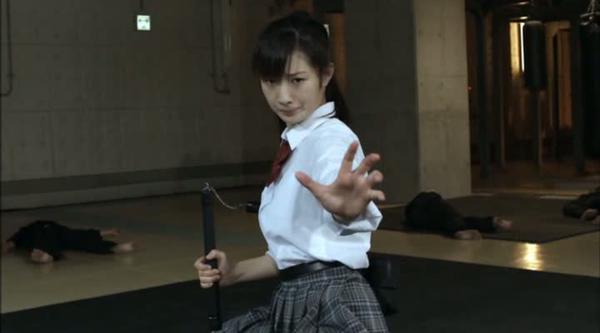KG – Karate Girl

2011![]()
Directed by Yoshikatsu Kimura
Written by Fuyuhiko Nishi

KG – Karate Girl is the followup to High Kick Girl!, and once again follows Rina Takeda around as she beats up people and kicks them in the head. This time, the movie is more Rina-centric, and we even get another female fighter in the form of 14 year old Hina Tobimatsu. Much of the creative team is back, High Kick Girl! director, producer, fight choreographer, and cowriter Fuyuhiko Nishi wrote KG, while High-Kick Girl!’s other writer Yoshikatsu Kimura takes the director chair this time out. Tatsuya Naka is also running around, but as he gets killed pretty quickly he isn’t in the film nearly as much as High-Kick Girl!

As a sophomore effort, KG shows signs of improvement, the story is easier to follow, though it is still steeped into the culture of karate and honor. The family dojo is on Okinawa (where karate began), one of the main plot points involves seizing a clan belt, and the evil Shu Tagawa has his own gang of karate thugs who dress in all black and invade dojos. Several of the bigger fighters are semi-famous martial arts champions, such as Richard Heselton and Tatsuya Naka.
A lot of time was spent making sure this was going to be filled with great action, Rina spent a year training for it (in addition to being an Ancient Dogoo Girl, and prepping for a slew of other film roles), and the training shots during the credits show the time that was taken to make sure the choreography was action packed.


|


We open as Ayaka’s father is fighting a gang of karate thugs led by the evil Shu Tagawa. Although he cripples Tagawa, Ayaka’s father is slashed with a killing blow. Ayaka’s sister Natsuke is kidnapped, their family karate belt stolen, and Ayaka left for dead. Her dad dies shortly after reviving her, and we jump to years later.
Ayaka works at a movie theater, where she foils some purse snatchers with some Karate Girl style justice. This causes a ginormous crowd of people to applaud and take pictures and record the video on their iPhones to upload to Japanese YouTube. I’m trying to think of an American theater where employees would even care if they saw a purse-snatching, the only thing I can think of is the manager would be mad if the purse was stolen before the patron paid for the overpriced 3D tickets and concessions. Maybe Alamo Drafthouse.


Tagawa’s evil karate gang is full of evil people who practice evil karate, we know this because they all wear black. Only the leaders can wear bits of other colors, and that’s just so they look more business evil. Tagawa is now in a wheelchair and wearing a black glove on one hand for extra evil evilness. He even punches one of his own men with his glove hand to show how evil he is. The Power Glove may be bad, but Tagawa’s black glove is extra bad! Their lead trainer is white guy Richard Heselton, who rants about how if you lose at karate, you die. I half expect him to start ranting about how pain doesn’t exist at this dojo.
One of the baddies is young girl Sakura, who is the kidnapped sister from the beginning of the film. A flashback lets us know the belts were switched so the baddies didn’t get the awesome karate belt. Remember, belts are awesome, and karate was invented to make it easier to beat up people and take their belts. The bad guys spot a blog article about Ayaka, so Tagawa sends Sakura and another young goon.


Ayaka gives a talk to a karate class about how karate is awesome but you should also be honorable, and does demonstration of kicking water bottles off of heads. Then the two black-clad baddies stroll in. I always find it hilarious that in these films bad guys just march right into rival dojos to cause trouble. I guess trespassing laws don’t exist in Japan. The guy talks trash to the class, then Sakura beats up everyone there. Ayaka agrees to fight them so they’ll stop beating everyone up.
Ayaka is hesitant at first, her fighting held back, but eventually it gets to the point where she just punches back the guys kicks with great strength, taking him out. Sakura is held at bay just by Ayaka holding her fist out.

After punishment back at the lair, Sakura stalks Ayaka to the pier, where Ayaka is practicing katas. Thus a new challenge is born and the girls fight again. After a bit of sparring, Ayaka recognizes Sakura’s stance as their fathers, and challenges her with her real name. Sakura doesn’t want to hear it, and runs away. As Sakura begins to have doubts as to her identity, she begins wearing a bit of white – a white t-shirt underneath the black sweatshirt. Transition is beginning, but when she re-enters the lair to be punished by being forced to fight another giant opponent, she’s back to all black – we can’t have the white showing in the lair of evil!
Sakura then she beats up the guy who is supposed to be punishing her, as she’s becoming a rebelling teen, striking out against her parents. Shu Tagawa then mocks her, as she rejects him and attacks she’s brought down by another of the karate thugs.
They text Ayaka a video of them threatening Sakura and demand the belt. Ayaka goes to kick some butt…but first she switches into a schoolgirl uniform instead of her karate duds. For some reason. To make the poster look better.


It’s KARATE TIME!!!!! Ayaka fights a whole host of bad dudes while trying to rescue her sister, while her sister fights a whole host of bad dudes trying to get rescued. There is a lot of neat choreography during this time, though as normal for this film, if you get punched or kicked once and aren’t a main character, you’re instantly unconscious. Aside from that, the fighting is neat and largely pure karate moves, there isn’t elaborate sets where characters swing around and rip off pieces to throw at each other. You can still have fun with pure moves, and KG does just that.
Ayaka takes a diversion to the roof to fight Richard Heselton’s white trainer…and it rains just as they get there for extra cinematography fun. But the rain barely sticks around and is gone after a minute or two. Tagawa is also on the roof. Heselton is so powerful he knocks her to the ground with each kick. But Sakura has made it to the roof as well so they can fight him together. Ayaka whips out the belt and Heselton realizes Tagawa lied about having the belt. Heselton may be tough, but even he can’t contend with multiple double-kicks to the head.
And then Ayaka bravely punches a guy in a wheelchair!

Triumphant, the girls practice karate stances on the beach back in Okinawa, Sakura is now Natsuke full time and clad in white karate clothes. She has gone the full Gandalf and is free. Though she still doesn’t smile until we see her during the movie training montage shots during the closing credits. Rina Takeda is the one singing the closing credits song Ready. Steady. Go!
As a followup, this was a good effort, continuing the style of film making done previous while making the story both simpler and more focused on Rina’s character. The keeping with the karate cultural aspects is in line with all the karate stunt actors who show up in the film, the creators and actors obviously have great respect for the martial art and those that practice it. There are a few parts that drag on as Ayaka comes to terms with realizing who her sister is and her father’s murderer returning, but all is forgiven as things enter the final 1/3 of the film and just become a karatefest. Even without subtitles, KG is enjoyable, and if you like High-Kick Girl!, this is a worthy successor.


Rated 9/10 (karated out, evil lady, evil glove, evil goon, evil trainer, evil goon, non-evil belt, Toei, statue)









